Waders in Wales

Over Halloween weekend I made a trip to Wales to take part in a wader ringing weekend organised by SCAN ringing group coordinated by fellow ex-Curlew field worker Steve Dodd. A busy weekend which involved mist netting Friday night and a cannon “shoot” on Saturday and Sunday. Ringing took place in a nature reserve between Bangor and Conwy in north Wales. After 11 hours of travel (bus x 3, ferry, train & a lift from Rachel), I met the assembled team (in the dark) who had set the mist nets. Base camp was set up (where birds would be ringed and processed) and I borrowed a set of waders (thanks Emilie) to join the extraction team in the wet muddy parts of the reserve.
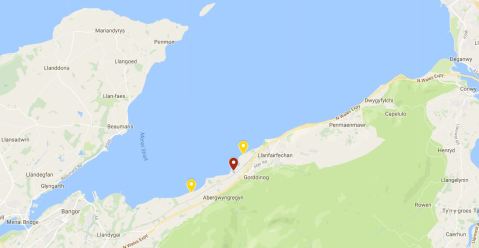
Approximate locations of mist netting (red) and cannon netting (yellow) sites
After a welcome slow start (allowing adjustment to the dark & the mud) the birds arrived and began appearing in the nets attracted by the tapes. We worked carefully, without light where possible, to extract the waders. Despite my experience with passerines, I found the extraction quite difficult, however Steve & Richard were always close by to help and offer tips. About an hour after high tide we closed the nets and went to assist the ringing & processing team. In total 82 Redshank, 34 Dunlin, 2 Curlew, 2 Black-tailed Godwits and a single Knot were caught. Once the last bird was released, all equipment was swiftly packed up and it was home for a few hours sleep before an early start to set cannon nets.
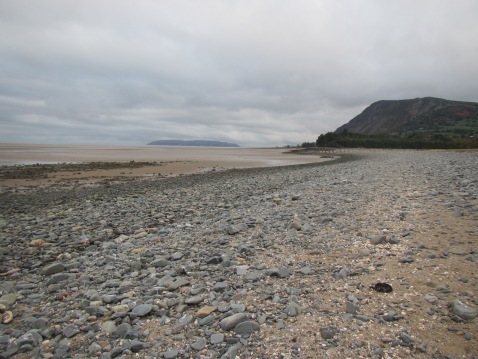
Looking north along the coast at Llanfairfechan – close to the cannon net site
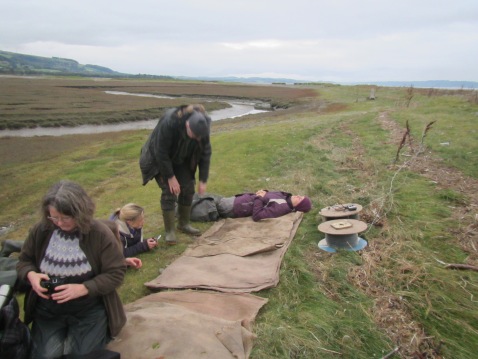
Getting comfortable next to the cables to wait for high tide to push birds close to the nets
Although this was my second time attending a cannon net “shoot” it was a very different experience. As the nets were being set from scratch each day I got to experience the whole process from start to finish. This gave me more of an understanding and appreciation of how much time, equipment and expertise is involved in cannon netting (and how many factors need to come together for it to work). I was delighted to be involved in many different parts (especially the connecting up the “chocolate blocks“) and everyone made sure I felt like part of the team and was kept busy!
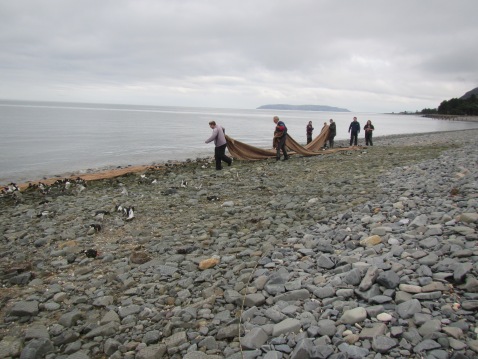
One of the first steps in the process is to cover the birds to keep them calm
After multiple briefings and what seemed like an eternity (patience is very important!), I heard the magic words “3,2,1” followed by bang. Everyone dashed to the net and got to work covering, extracting, placing birds in keeping cages and finally ringing and releasing.

The team working together to extract birds and shuttle them to the keeping cages
Once birds were safely in keeping cages, we divided up into teams and the ringing and processing began.
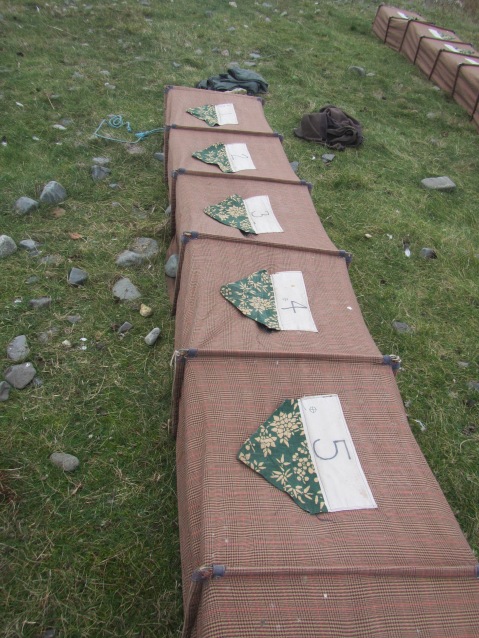
The numbered keeping cages, made from heavy duty fabric, have velcro “lids” with an opening underneath for inserting and removing birds
Among the 418 Oystercatchers (the target species for the catch) and 25 Curlew caught we had one Bar-tailed Godwit and one Black-tailed Godwit. I was given the chance to ring the Bar-tailed Godwit and it was a great opportunity to see these two very similar species up close and compare their differentiating features.
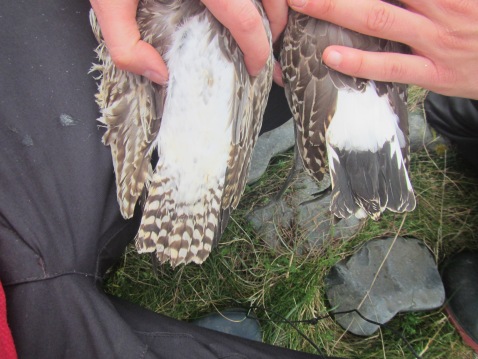
Comparing the tails of Bar-tailed Godwit (left) and Black-tailed Godwit (right)

Ageing and ringing the Oystercatchers – all overseen by Dave and Richard

The processing team lead by Steve & Rachel with Tom, Will & Orinoco to keep everyone company!
About one third of the Oystercatchers caught were already ringed. The majority of these were ringed in previous years by the SCAN group (retraps), with the oldest retrap of the day being 29 years old – older than quite a few members of the ringing group. The record for the longest living Oystercatcher in the BTO ringing scheme currently stands at 40 years, 1 month and 2 days. Among the ringed birds, we had 3 foreign controls, ringed in Iceland including JA a colour ringed bird. Initially I thought the colour ring was not white, but faded yellow meaning it could belong to the Dublin Bay Birds Project, but I was wrong, it was just dirty!
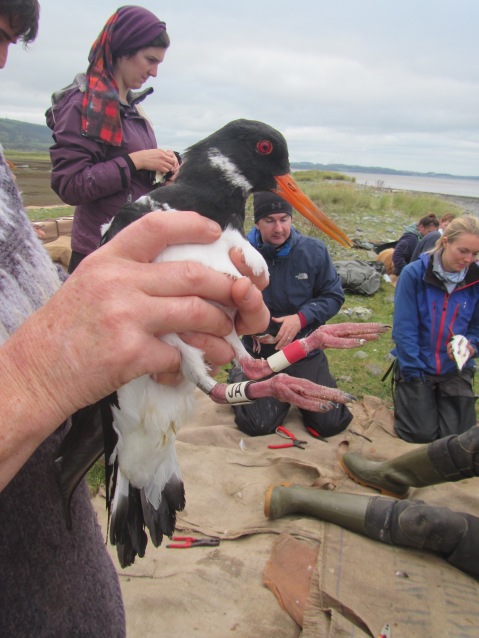
Oystercatcher (JA) originally colour ringed in Iceland controlled by SCAN ringing group in North Wales
By mid afternoon all birds had been ringed and released and it was time to pack up. Another efficient clean up operation meant more time available for tea drinking and rest. On Sunday morning a net was set in a green field, before high tide, with the aim of catching Curlew. After all equipment was set up, I was given the opportunity to be part of the team that would sit in the hide, so I had a birds eye view of moments before the net being shot.
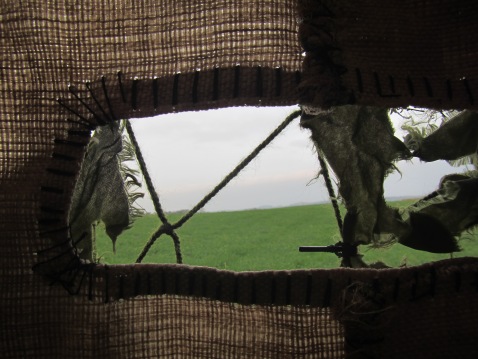
View from the inside of the hide
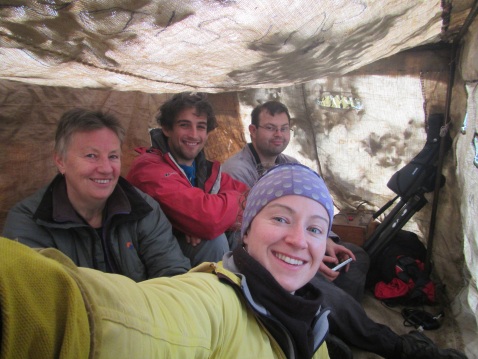
Hide Team – with Ava, Tom and Richard
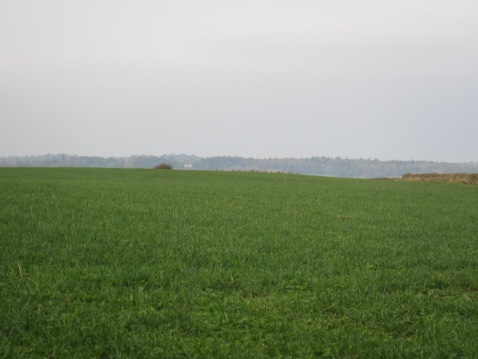
Curlew gathering next to decoys in the field just below the tree line
A few new pieces of equipment were introduced to me, including the hide and the “jiggler” (not the gigolo as I called it) – a simple but useful piece of string used to gentle encourage the birds away from the area immediately in front of the cannons (it appears cannon netting has it’s only set of terminology!)

Some of the team members ringing and processing Curlew
I thoroughly enjoyed a very well organised weekend catching waders with a group of knowledgeable and friendly ringers. I would definitely recommend a visit for any ringer interested in experiencing cannon netting.
Finally catch totals for the weekend (from my notes):
- 418 Oystercatcher
- 82 Redshank
- 47 Curlew
- 34 Dunlin
- 3 Black-tailed Godwit
- 1 Bar-tailed Godwit
- 1 Knot
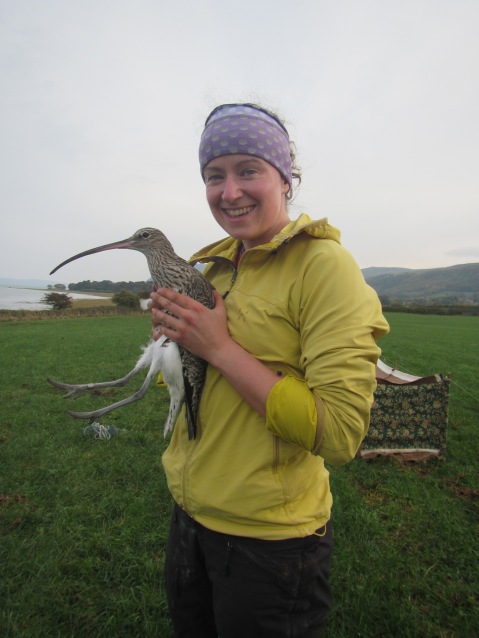
It’s been a Curlew year for me – from surveying on the breeding grounds in the summer to ringing on the coast in the winter
Put Louth on the map!
Louthonians, if we can be called that, you help is needed, and rather urgently! The National Biodiversity Data Centre, the organisation that collects information about plants & animals in Ireland, are putting together a Mammal Atlas, a map of all the wild mammals in Ireland. To do that, they need records from people living in every county in Ireland (that’s you!). To date, very few records have been received from county Louth. We are almost at the bottom of the leader board, with only around 150 records submitted!

Get Louth off the bottom of the county leader board!
To lift us from the bottom, I am asking all Louth residents who have spotted a badger, hare, fox, squirrel (both red and grey) or any other wild mammal to send this information to the NBDC. You can also report sightings of road kill and cetaceans (whales, dolphins etc.). It only takes a minute via this link, and it will literally put Louth on the map!

Records of wild mammals wanted! Photo: NBDC website
